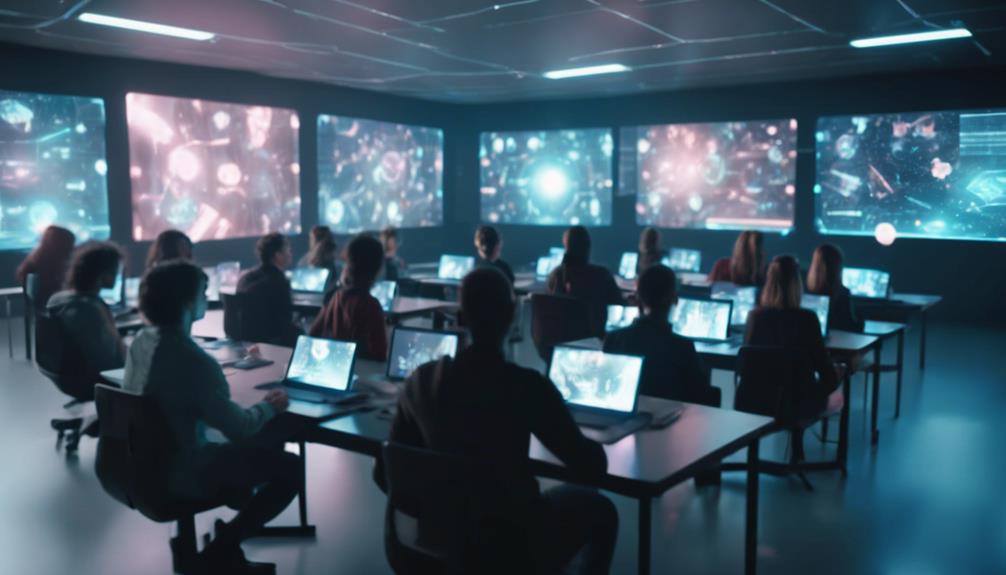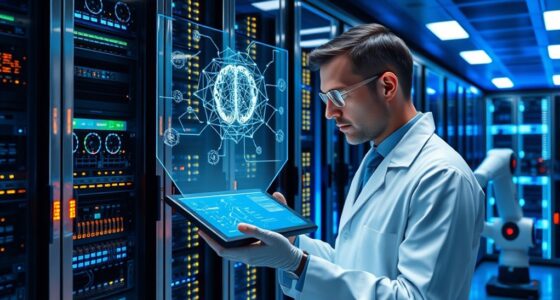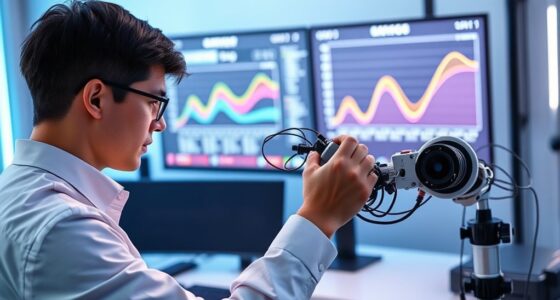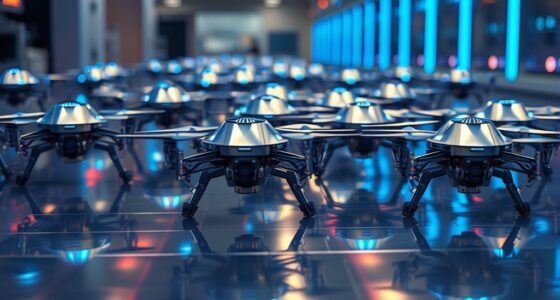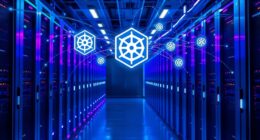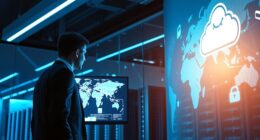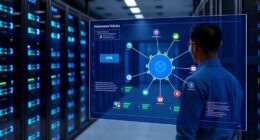Reinforcement Learning (RL) AI is a powerful tool in virtual simulations aimed at solving climate change, but applying it to real life isn't without challenges. While RL has had successes, like reducing energy consumption and managing resources effectively, translating these results to our complex world requires high-quality simulations that accurately represent real conditions. Issues like model fidelity and adaptability can hinder real-world effectiveness. However, ongoing advancements in technology and collaboration hold promise for bridging this gap. If you're curious about the future of RL and climate solutions, there's more to discover.
Key Takeaways
- High-quality simulations are essential for RL training, but fidelity gaps can hinder real-world applicability of learned policies.
- Successful RL applications in energy efficiency and resource management showcase potential real-world benefits, but challenges remain in transferability.
- Inaccurate simulations and static policies limit RL's effectiveness in dynamic environments, necessitating iterative refinement and adaptability.
- Real-time data integration and accurate modeling are critical for improving RL strategies and optimizing climate change interventions.
Overview of Reinforcement Learning AI
Reinforcement Learning (RL) is a dynamic subset of machine learning that helps you teach agents to make decisions by rewarding or penalizing their actions based on feedback from the environment.
Fundamentally, RL allows you to optimize complex tasks through a process of trial and error, making it particularly effective in dynamic environments. Here, agents learn to adapt their strategies based on the consequences of their actions, which can range from achieving high scores in gaming to maneuvering through complex real-world scenarios like climate change.
To implement RL successfully, high-quality simulation environments are essential. These environments provide a controlled space where agents can learn without real-world risks.
However, just training in simulations isn't enough; agents need to transfer their learning to actual situations. This is where transfer learning comes into play, bridging the gap between simulated learning and real-world application.
Despite the challenges in achieving fidelity and accuracy, the potential of RL in decision making is immense. By leveraging this technology, you can tackle intricate problems and improve outcomes across various fields, setting the stage for innovative solutions in tackling climate change.
Simulations Vs. Real-World Applications

Effective simulations can greatly enhance the training of AI agents, but translating those skills to real-world applications often presents unique challenges. While reinforcement learning (RL) agents can thrive in simulated environments, these simulations must accurately reflect complex environments to guarantee success. Mismatches in physics or environmental parameters can lead to RL policies that falter when faced with real-world conditions.
To bridge this gap, a hybrid approach is crucial. By initially training RL agents in simulations, you can then make necessary adjustments using real-world data. This method allows for continuous refinement of policies, enhancing overall performance. However, the fidelity of these simulations is critical; using fixed values and simplified physics can limit the applicability of solutions meant to tackle real-world issues like climate change.
As research continues to improve simulation techniques, achieving better alignment with real-world dynamics will become increasingly important. The ultimate goal is to guarantee that the skills developed through simulations translate effectively into real-world applications, providing robust solutions to the challenges posed by climate change.
Challenges in Implementation

You'll quickly notice that simulation fidelity is a major hurdle when trying to implement reinforcement learning in real-world scenarios.
If the simulations don't accurately reflect real-life conditions, the policies you develop might fail to work outside the virtual environment.
Addressing these gaps is essential for effective policy transfer and successful climate change interventions.
Simulation Fidelity Issues
Simulation fidelity plays a critical role in the successful application of RL agents, as inaccuracies can lead to ineffective policies when faced with real-world complexities. When training RL agents, you need to make sure that your simulations accurately reflect the real world. This means developing accurate physics models, appropriate time steps, and realistic noise levels.
| Key Factors | Simulation Environment | Real-World Application |
|---|---|---|
| Physics Models | Simplified | Complex |
| Time Steps | Fixed | Variable |
| Noise Levels | Controlled | Unpredictable |
Custom simulation environments can be tailored to better match real-world parameters, but they often still fall short. Simplified physics models can't capture the nuances of complex systems, which can hinder the transfer of learned policies. To address these challenges, it is crucial to combine simulation training with real-world adjustments, creating a more robust approach. This way, you can enhance the performance of RL agents and improve their effectiveness in real-world applications. Focusing on simulation fidelity will ultimately lead to more successful implementations of reinforcement learning strategies against climate change.
Real-World Policy Transfer
Real-world policy transfer from reinforcement learning (RL) agents trained in simulations presents significant challenges due to discrepancies in how these agents interact with unpredictable environments.
When you're working with RL, the fidelity of your simulations matters tremendously. If the physics models don't match real-world conditions, your policies mightn't perform effectively. Furthermore, environmental noise in real scenarios can derail even the best-trained agents, causing them to falter.
During the training phase, a lack of accurate real-world data can lead to models that struggle to generalize. To combat this, customizing simulation environments to better reflect real-world scenarios is vital. However, even with refined simulations, limitations in the models can still hinder successful policy transfer.
Successful implementation requires iterative refinement through field testing, where you'll likely need to make significant adjustments to your initial controller designs. Adapting these policies to cope with practical challenges is fundamental, as RL agents must navigate complexities that simulations mightn't fully capture.
Essentially, bridging the gap between simulation and reality is an ongoing process that demands careful consideration and continuous improvement.
Success Stories and Case Studies

You'll find that reinforcement learning has sparked impressive success stories across various sectors tackling climate change.
From boosting renewable energy efficiency to optimizing resource use in agriculture, these real-world applications showcase the technology's potential.
However, it's also essential to examine the lessons learned from past failures to enhance future implementations.
Real-World Applications
Numerous success stories highlight how Reinforcement Learning (RL) is transforming energy efficiency and resource management across various sectors.
In smart grids, RL agents have achieved a remarkable 10% reduction in energy consumption while maintaining service quality in a simulated urban environment. This showcases RL's potential to optimize energy use effectively.
In agriculture, a case study demonstrated that RL could manage irrigation systems, leading to a 15% decrease in water usage and increased crop yields. This not only improves resource management but also supports sustainable farming practices.
Urban traffic management has also benefited, with RL algorithms reducing congestion and emissions by 20% in simulations, paving the way for more sustainable cities.
Furthermore, RL has shown a 25% increase in efficiency when optimizing renewable energy storage systems, enhancing the integration of solar and wind energy into power grids.
Finally, in wildfire management, RL techniques successfully predicted and mitigated fire spread in simulated scenarios, illustrating their potential for real-world environmental crisis response.
These examples prove that RL isn't just theoretical; its real-world applications are making a tangible impact on energy efficiency and resource management.
Learning From Failures
While successes in Reinforcement Learning (RL) applications are impressive, the journey also includes valuable lessons learned from failures that can enhance future efforts in tackling climate change. By analyzing these setbacks, you can identify areas for improvement, leading to more effective strategies in real-world applications.
Consider these key takeaways:
- Optimization Challenges: Initial RL models may struggle with complex scenarios, emphasizing the need for better algorithms and simulations to handle the intricacies of climate change.
- Resource Management Failures: Some attempts at optimizing resource use have fallen short due to inaccurate predictive models, highlighting the importance of integrating real-time data for improved decision-making.
Future Prospects for Climate Solutions
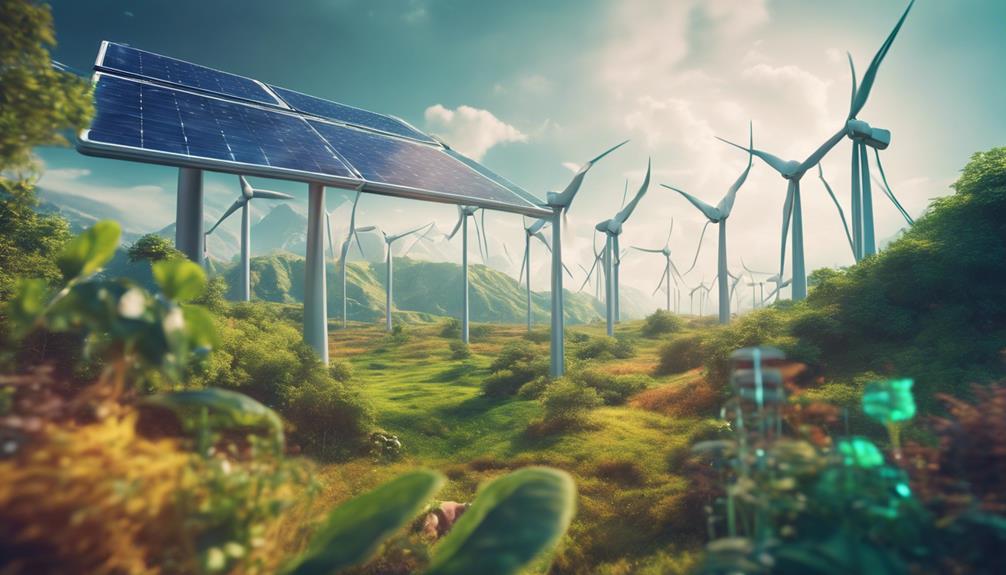
Harnessing the power of reinforcement learning, researchers are paving the way for innovative and effective climate solutions that can adapt to evolving environmental challenges. As RL agents optimize strategies in virtual simulations, they improve efficiency in resource management and emissions reduction. These adaptive strategies hold promise for real-world implementation, especially in areas like renewable energy grids and predicting extreme weather events.
| Aspect | Current Achievements | Future Potential |
|---|---|---|
| Emissions Reduction | RL optimizes power usage in renewable grids | Significant global emissions cuts |
| Resource Management | Efficient allocation in simulated environments | Improved resource distribution |
| Weather Prediction | Accurate forecasting in high-fidelity simulations | Enhanced disaster preparedness |
| Interdisciplinary Collaboration | Ongoing research across various fields | Broader application of solutions |
The transfer of RL-trained policies to reality depends on high-fidelity simulations that mirror real-world parameters. Interdisciplinary collaboration is essential to refine these models, ensuring they scale across different regions and sectors. The future of climate solutions looks promising, and with continued innovation, we can harness AI to combat climate change effectively.
Collaborative Efforts and Innovations

Collaborating across sectors, researchers and organizations are driving innovative AI solutions to tackle climate change and enhance resilience against its impacts.
These collaborative efforts leverage AI to improve predictive modeling, which is essential for anticipating extreme weather events and allowing for timely, data-driven responses.
You can see how these initiatives are shaping a more sustainable future through the following examples:
- AI for the Planet Alliance: This initiative engages partners like BCG and UNESCO to develop AI-driven solutions for climate change mitigation and adaptation.
- Blue Sky Analytics: Utilizing satellite data, they provide actionable environmental intelligence, bridging gaps across sectors to address climate challenges effectively.
Frequently Asked Questions
Can the Environment Be Simulated or Real in Reinforcement Learning?
You can simulate environments in reinforcement learning, but ensuring they accurately reflect reality is essential. Mismatches in parameters can lead to ineffective strategies, so focus on refining simulations for better real-world applicability and performance.
Can We Use AI to Solve Climate Change?
Yes, you can use AI to tackle climate change. By optimizing resource management and enhancing predictive modeling, AI helps you make informed decisions, improving strategies for adaptation and mitigation in real-world scenarios.
What Are the Benefits of Reinforcement Learning in Ai?
You might think reinforcement learning isn't practical, but its benefits are clear. It optimizes strategies through trial and error, adapts in real-time, and analyzes vast data, leading to improved decision-making and more effective solutions across various fields.
What AI Application Can Be Used to Help With Sustainability Problems?
You can use AI applications like predictive analytics to optimize resource management, enhance climate modeling, or implement intelligent irrigation systems. These tools help reduce waste, improve efficiency, and promote sustainable practices for a healthier planet.
Can AI’s success in virtual simulations translate to real-world applications in solving complex problems like climate change?
Can AI’s success in virtual simulations translate to real-world applications in solving complex problems like climate change? The potential for ai driving surpasses humans. With advanced technology, AI can gather and analyze data to optimize energy usage, develop sustainable solutions, and simulate potential climate change scenarios to inform decision-making.
Conclusion
Reinforcement learning AI shows great promise in tackling climate change, especially through virtual simulations.
For instance, studies suggest that AI can optimize energy usage by up to 30% in smart grids, illustrating its potential impact.
However, translating these successes to the real world isn't without challenges. Continued collaboration and innovation will be essential for overcoming obstacles.
If we harness this technology effectively, we might just pave the way for groundbreaking solutions to one of humanity's greatest crises.

